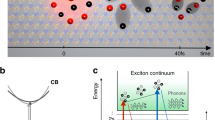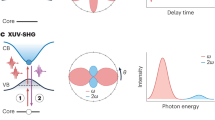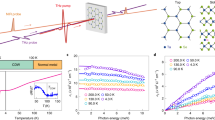Abstract
Many-body systems in nature exhibit complexity and self-organization arising from seemingly simple laws. For example, the long-range Coulomb interaction between electrical charges has a simple form, yet is responsible for a plethora of bound states in matter, ranging from the hydrogen atom to complex biochemical structures. Semiconductors form an ideal laboratory for studying many-body interactions of electronic quasiparticles among themselves and with lattice vibrations and light1,2,3,4. Oppositely charged electron and hole quasiparticles can coexist in an ionized but correlated plasma, or form bound hydrogen-like pairs called excitons5,6. The pathways between such states, however, remain elusive in near-visible optical experiments that detect a subset of excitons with vanishing centre-of-mass momenta. In contrast, transitions between internal exciton levels, which occur in the far-infrared at terahertz (1012 s-1) frequencies7,8,9, are independent of this restriction, suggesting10 their use as a probe of electron–hole pair dynamics. Here we employ an ultrafast terahertz probe to investigate directly the dynamical interplay of optically-generated excitons and unbound electron–hole pairs in GaAs quantum wells. Our observations reveal an unexpected quasi-instantaneous excitonic enhancement, the formation of insulating excitons on a 100-ps timescale, and the conditions under which excitonic populations prevail.
This is a preview of subscription content, access via your institution
Access options
Subscribe to this journal
Receive 51 print issues and online access
$199.00 per year
only $3.90 per issue
Buy this article
- Purchase on Springer Link
- Instant access to full article PDF
Prices may be subject to local taxes which are calculated during checkout




Similar content being viewed by others
References
Shah, J. Ultrafast Spectroscopy of Semiconductors and Semiconductor Nanostructures (Springer, Berlin, 1999)
Chemla, D. S. & Shah, J. Many-body and correlation effects in semiconductors. Nature 411, 549–557 (2001)
Rashba, E. I. Excitons (North-Holland, Amsterdam, 1982)
Perakis, I. Exciton developments. Nature 417, 33–35 (2002)
Lundstrom, T., Schoenfeld, W., Lee, H. & Petroff, P. M. Exciton storage in semiconductor self-assembled quantum dots. Science 286, 2312–2314 (1999)
Bayer, M., Stern, O., Hawrylak, P., Fafard, S. & Forchel, A. Hidden symmetries in the energy levels of excitonic ‘artificial atoms’. Nature 405, 923–926 (2000)
Groeneveld, R. H. M. & Grischkowsky, D. Picosecond time-resolved far-infrared experiments on carriers and excitons in GaAs–AlGaAs multiple quantum wells. J. Opt. Soc. Am. B 11, 2502–2507 (1994)
Timusk, T. Far-infrared absorption study of exciton ionization in germanium. Phys. Rev. B 13, 3511–3514 (1976)
Černe, J. et al. Terahertz dynamics of excitons in GaAs/AlGaAs quantum wells. Phys. Rev. Lett. 77, 1131–1134 (1996)
Kira, M., Hoyer, W., Stroucken, T. & Koch, S. W. Exciton formation in semiconductors and the influence of a photonic environment. Phys. Rev. Lett 87, 176401 (2001)
Huber, R. et al. How many-particle interactions develop after ultrafast excitation of an electron–hole plasma. Nature 414, 286–289 (2001)
Beard, M. C., Turner, G. M. & Schmuttenmaer, C. A. Transient photoconductivity in GaAs as measured by time-resolved terahertz spectroscopy. Phys. Rev. B 62, 15764–15777 (2000)
Lövenich, R., Lai, C. W., Hägele, D., Chemla, D. S. & Schäfer, W. Semiconductor polarization dynamics from the coherent to the incoherent regime: Theory and experiment. Phys. Rev. B 66, 045306 (2002)
Nuss, M. C. & Orenstein, J. in Millimeter and Submillimeter Wave Spectroscopy of Solids (ed. Grüner, G.) 7–50 (Springer, Berlin, 1998)
Dressel, M. & Grüner, G. Electrodynamics in Solids 61–62 (Cambridge Univ. Press, Cambridge, 2002)
Haug, H. & Koch, S. W. Quantum Theory of the Optical and Electronic Properties of Semiconductors (World Scientific, Singapore, 1994)
Gerlach, B., Wüsthoff, J., Dzero, M. O. & Smondyrev, M. A. Exciton binding energy in a quantum well. Phys. Rev. B 58, 10568–10577 (1998)
Tzoar, N. & Platzman, P. M. High-frequency conductivity of a two-dimensional, two-component electron gas. Phys. Rev. B 20, 4189–4193 (1979)
Wegener, M. et al. Femtosecond dynamics of excitonic absorption in the infrared InxGa1-xAs quantum wells. Phys. Rev. B 39, 12794–12801 (1989)
Selbmann, P. E., Gulia, M., Rossi, F., Molinari, E. & Lugli, P. Coupled free-carrier and exciton relaxation in optically excited semiconductors. Phys. Rev. B 54, 4660–4673 (1996)
Siantidis, K., Axt, V. M. & Kuhn, T. Dynamics of exciton formation for near band-gap excitations. Phys. Rev. B 65, 035303 (2002)
Oh, I. K. Exciton formation assisted by LO phonons in quantum wells. Phys. Rev. B 62, 2045–2050 (2000)
Betz, M. et al. Nonlinear optical response of highly energetic excitons in GaAs: Microscopic electrodynamics at semiconductor interfaces. Phys. Rev. B 65, 085314 (2002)
Siarkos, A., Runge, E. & Zimmermann, R. Center of mass properties of the exciton in quantum wells. Phys. Rev. B 61, 10854–10867 (2000)
Damen, T. C. et al. Dynamics of exciton formation and relaxation in GaAs quantum wells. Phys. Rev. B 42, 7434–7438 (1990)
Blom, P. W. M., van Hall, P. J., Smit, C., Cuypers, J. P. & Wolter, J. H. Selective exciton formation in thin GaAs/AlxGa1-xAs quantum wells. Phys. Rev. Lett. 71, 3878–3881 (1993)
Deveaud, B., Sermage, B. & Katzer, D. S. Free exciton versus free carrier luminescence in a quantum well. J. Phys. Colloq. C 5, 11–14 (1993)
Kumar, R., Vengurlekar, A. S., Prabhu, S. S., Shah, J. & Pfeiffer, L. N. Picosecond time evolution of free electron-hole pairs into excitons in GaAs quantum wells. Phys. Rev. B 54, 4891–4897 (1996)
Landau, L. & Zeldovich, J. On the relation between the liquid and gaseous states of metals. Acta Physicochim. USSR XVIII 2–3, 194–196 (1943)
Mott, N. F. Metal Insulator Transitions (Taylor and Francis, London, 1990)
Acknowledgements
We thank J. Reno for growth of the quantum well samples, and S. L. Chuang for band-structure calculations. We also thank M. Kira, S. W. Koch, M. Woerner, T. Timusk and J. Orenstein for discussions. This work was supported by the Office of Basic Energy Sciences of the US Department of Energy, the Deutsche Forschungsgemeinschaft and the Alexander von Humboldt Foundation.
Author information
Authors and Affiliations
Corresponding author
Ethics declarations
Competing interests
The authors declare that they have no competing financial interests.
Rights and permissions
About this article
Cite this article
Kaindl, R., Carnahan, M., Hägele, D. et al. Ultrafast terahertz probes of transient conducting and insulating phases in an electron–hole gas. Nature 423, 734–738 (2003). https://doi.org/10.1038/nature01676
Received:
Accepted:
Issue Date:
DOI: https://doi.org/10.1038/nature01676
This article is cited by
-
Terahertz time-domain spectroscopy
Nature Reviews Methods Primers (2023)
-
Exciton formation dynamics at the SiO2/Si interface
Communications Materials (2023)
-
Charges tied with magnetic strings
Nature Physics (2023)
-
A Hubbard exciton fluid in a photo-doped antiferromagnetic Mott insulator
Nature Physics (2023)
-
Quantum criticality of excitonic Mott metal-insulator transitions in black phosphorus
Nature Communications (2022)
Comments
By submitting a comment you agree to abide by our Terms and Community Guidelines. If you find something abusive or that does not comply with our terms or guidelines please flag it as inappropriate.



